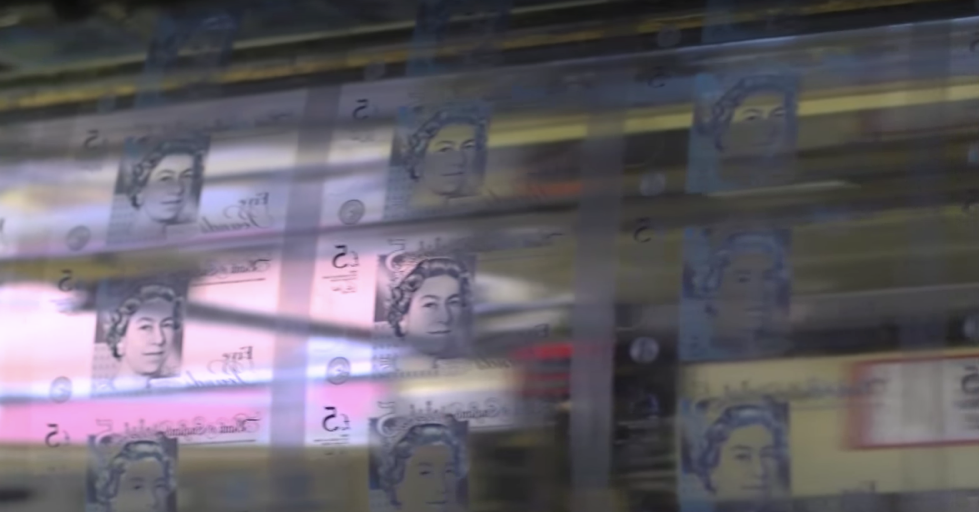
It’s always entertaining whenever somebody tries to critique MMT using the term “money printing”. There is no greater tell that the person hasn’t the first clue what they are talking about, and that they are still in thrall to the Wizard of Oz illusion rather than understanding what is going on behind the curtain.
Once you take the time to actually understand MMT and what it is explaining then you’ll know that money printing is a form of taxation.
All of which follows, once again, from understanding the institutional structure of how notes come about and how they affect the balance sheets of the organisations that use them.
How Cash Gets in Your Hands
Let’s go through the process, so you can see how this apparent paradox comes about.
In the UK, bank notes are primarily the responsibility of the Bank of England. Legislation splits the balance sheet of the Bank of England in two. There is the Banking Department which does the normal central banking operations and the Issue Department which looks after the creation and distribution of bank notes. The two are accounted separately in the Bank of England Accounts.
Officials in the Issue Department instruct a printer, currently De La Rue, to create bank notes who are paid for their services by the Bank in the usual fashion: charging the appropriate HM Treasury account in the Banking Department, marking up the Banking Department account of De La Rue’s banker and issuing an instruction to that bank to mark up De La Rue’s account.
This is the cost of production of the notes, which last year totalled some £78 million.
After that, the notes are distributed throughout the banking system, based upon the demand of the commercial banks for notes to fill their cash machines and counter tills. This happens via the Note Circulation Scheme and Wholesale Cash Distribution network. (Gory details in this current review)
Note distribution costs the Bank of England £31 million, which again it pays by transfer from the appropriate HM Treasury owned account.
In total £117 million was paid out in FY2019 for to create and distribute notes.
Now the Taxing Part
How do the Banks demand the notes in the first place?
By offering assets in exchange.
Specifically deposits held at the Banking Department of the Bank of England or Gilts/Treasury Bills issued by HM Treasury.
Which of course they have to have on hand before they can order any notes from the printers.
If the bank tenders a deposit at the Banking department, then the commercial bank’s deposit is reduced (debited) and the Issue Department’s account in the Banking Department increased (credited).
If the bank tenders a Gilt or Treasury Bill, then the Issue Department enters into a reverse repo arrangement with the bank, where the underlying settlement is to return the notes, or a Banking Department deposit.
Both of these processes mean that the commercial bank hands over interest bearing assets to the Issue Department in return for non-interest bearing notes. The resulting reduction in income of the bank is the tax.
The notes end up as assets on the bank’s balance sheet, where they stay until you go to a Cashpoint and draw some out, whereupon the liability of the bank to you is reduced, and so is the bank’s stock of notes.
How Big is the Tax?
The banks have to pay the face value of the notes, not just the production costs. For FY2019 the banks transferred to the Issue Department £257 million of assets in exchange for additional notes.
That £257 million is added to the asset pile in the Issue Department which totalled £71.7 billion at FY2019 and which generated £703 million in income. £555 million of which was transferred back to HM Treasury.
All of this is income the banks would have earned had they no notes.
Hold On. Haven’t I Seen This Before?
The process is remarkably similar to that used by the Asset Purchase Facility (the UK’s implementation of QE - Quantitative Easing) which does essentially the same thing on the Banking Department side. Income earning assets of the banks and financial companies are removed and replaced with lower income earning assets, with the difference paid over to HM Treasury. It’s just another form of tax reducing the income of the non-government sector.
And that’s why, despite mountains of QE, not a lot has happened. First you have to overcome a £14.5 billion drain in income.
Now when you see somebody talking about “money printing” you can smile quietly to yourself and think…

For a US explanation, see Scott Fullwiler’s paper “When the Interest Rate on the National Debt Is a Policy Variable (and “Printing Money” Does Not Apply)”